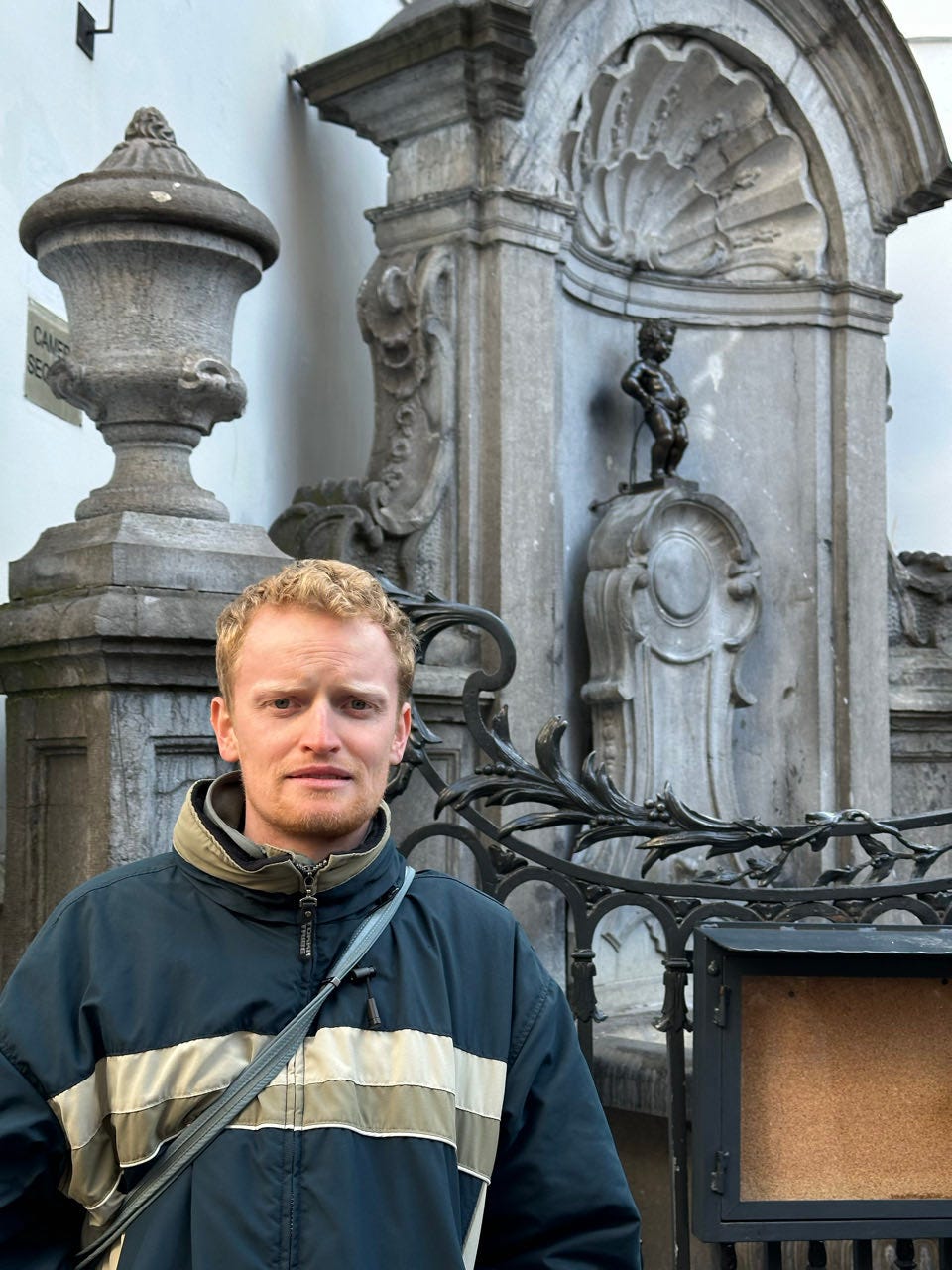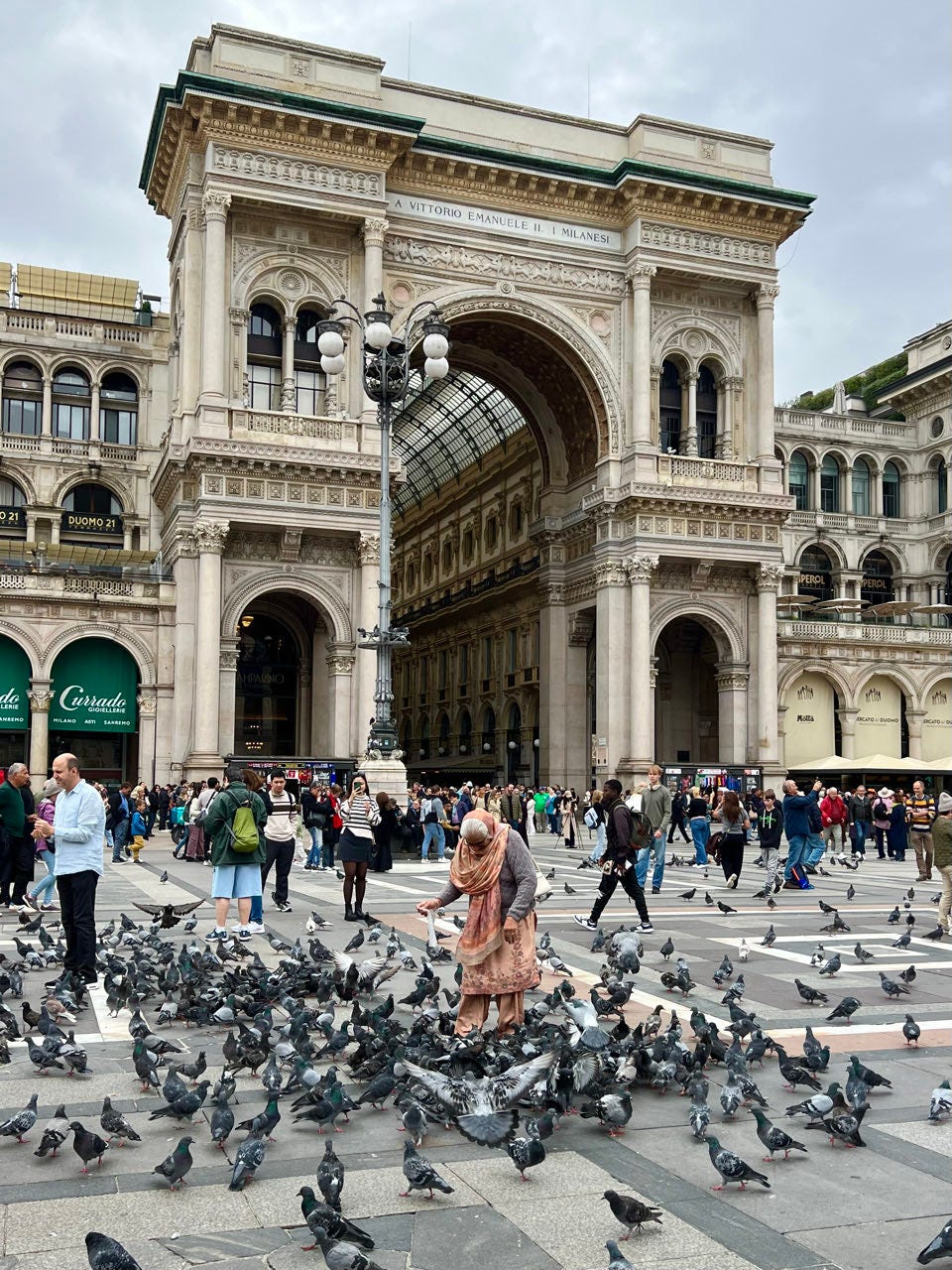The Palace of Versailles is like an old money version of Las Vegas. I mean no disrespect. It’s just that there’s a very high density of mirrors and gold, architraves that make you feel underdressed, frilly bedding, It Girl chandeliers, priceless art in the foyer because it doesn’t all fit in the galleries, acres of garden in full unseasonal bloom, fountains, hireable golf buggies, pleasing symmetries at unwieldy scales, satellite palaces ensconced in sheer hedges, lakes big enough for rowing clubs, and myriad marble statues of gods undone by their greed.
No wonder the French had so many revolutions.
We’re learning that landmarks are always mightier in the flesh. Full. Commanding. Exhausting even just to behold. Almost a little freaky, actually, like a photograph that’s been brought to life and is overbearing in every way.
Examples. Aptly named Big Ben somehow still surprising in its bigness. The Berlin Wall starkly unjumpable. White, spired Italian cathedrals, all taken very seriously. Prague Castle looms large, literally and figuratively and historically. Intricate network of indistinguishable canals turn Amsterdam into one big Mobius Strip. And of course, the only place in Paris where you can’t see the Eiffel Tower is actually on the Eiffel Tower—we have to schlep back down the bastard, push through three different throngs, then go up a hundred marble stairs just to fit the whole glittering thing to fit in our cameras.
City sights are a special sort of surreal. Often beautiful confections of bricks and metal, sometimes so striking as to feel like a physical blow. But here’s a question that doesn’t get much airtime on TripAdvisor: How long do you need to look at the Eiffel Tower in order to fully get it? And once it’s been got, where do you go? Just, like, home? Because ten minutes later we stop in at a grocery store, and whenever I blink I can still see the high-watt lights of the Eiffel Tower seared on my retinas, and now I’m trying to remember if we need more milk, and it all feels very very strange.
Brussels, in the bowels of Belgium, is the beating administrative heart and de facto capital of the European Union. It is also home to three widely-revered ‘pissing statues.’ Three is actually a lot. Though we’ve seen some very creative water fountains across continental Europe, involving mermaids with swords and babies choking dragons and what have you, nowhere but Brussels is anyone actually pissing out the stream of water. This leads to the curious phenomenon of official miniaturised replica ‘Pissing Boy’ statues being sold in the same souvenir shop as EU branded scientific calculators.
If you think the statue vulgar, you might be right. If you think it unappealing to the masses you would be embarrassingly wrong and out of touch, since the only meaningful concentration of tourists we’ve seen in this city is smooshed against the fountain wall.
How to photograph this attraction? Why to photograph this attraction?
It is, if nothing else, a refreshing change of pace from museums and bridges. Parliament houses. And castles. Memorial plinths, victory columns. So many wars here. So much art. And please dear god not another beautiful church, they’re starting to make me feel funny.
Umbrella salesmen in Milan are among the most organised and relentless in the world. Some camp out around metro stations, others form roving strike units. They’re everywhere that rain is—an unlikely but truly and literally saturated market. They harry and heckle. They often offer auxiliary 2-for-1 deals on portable chargers. And they treat a simple ‘No thank you,’ as the promising beginning of a long and fruitful business relationship. One guy has the audacity to yell, ‘Umbrella boss?’ while I’m actively holding an umbrella, and when I decline he says that my umbrella is cheap flimsy plastic crap and that his umbrella, for €4.00, cash only, is the real deal.
This is shocking and fun for like a day. Welcome to the big smoke, kid! Life moves quick! But then there’s also the guys pushing fresh roses on young couples, and the private boat tourers wolf whistling from the canals, and the unabashed upselling during Happy Hours, and the cloaked gentlemen trying to shove pigeon feed into your hands outside the Duomo. When you take stock, you’ll realise a pretty big part of your day in Milan is saying No, firmly, to strangers, at which point their smile will dissolve and they’ll look right through you as if you’re no longer there.
The guys outside the Sacre Coeur will actually grab your arm. Brash London cartoonists will goad you into posing. It’ll only take five minutes! It’s only twenty quid! And it’s kind of the same thing at Disneyland, except that instead of selling umbrellas they’re selling happiness, and instead of vaguely menacing men following you around, sales are executed by cute, anthropomorphised mice. It’s tempting to avoid all designated tourist zones for this reason. But it’s hard, because we are tourists—cool, socially conscious, spatially aware tourists, we’d like to think—and so we want to see things that are busy enough to be worth visiting but not so busy with other tourists as to be unpleasant. A razor thin inflection point. Often surpassed.
Among the MOUNTAINS, one might think of oneself as a human being with a certain inherent, inalienable value. The METROPOLIS wastes no time in making one feel like one is in actual fact a thing—if not a mark or a rube then at least a sort of walking pinata—from which value can be extracted and spread evenly amongst the city.
There’s this dark, apocryphal joke that the Astronomical Clock was so good, so cool, that Prague’s King felt compelled to relieve its creator of his eyeballs so he couldn’t make another somewhere else. The tour guide gets the actual giggles during this story—and if I was a paying member of his tour I might have more of a problem with it. As it happens, I’m eavesdropping. Prague is so packed with walking tours that you can learn a lot of history by simply loitering around key attractions and listening.
The clocktower is six hundred years old. The clockface is a series of intricate golden loops that plot—with apparently ‘eerie’ accuracy—the interrelated paths of the sun, moon, and actual time. When it strikes the hour it comes alive. Chimes and bells. Dancing skeletons. Two old wooden doors slide open, and unsmiling figurines of the twelve apostles spin hurriedly by, as if running late for a meeting with Jesus. The large crowd is pin-drop quiet during this spectacle. When it’s all over there’s a smattering of applause, like you might hear when a plane lands.
But Prague’s medieval fun doesn’t stop at the clock! The grand old Castle is thick and heaving with tourists, even on a dreary October weekday with no sun to speak of. Antiquated attractions abound! The old torture chamber, for instance! Bodies cram around the crown jewels. There’s a line to stand in front of the window where the bigger defenestrations happened. Franz Kafka’s one-time, one-bed-no-bath apartment on the Castle’s Golden Lane has been turned into a Franz Kafka book store, complete with dewy eyed salespeople who say spooky things like ‘He probably wrote A Hunger Artist in the very spot you’re standing.’ And then there’s the changing of the guard, which everyone turns out to see, that (ceremonially) marches the very thin line between regal and silly.
The busyness of this long-out-of-business Castle is its own kind of spectacle, in that it’s so far past the tourist density inflection point that it starts to almost be fun again. The best example is the line for the Basilica of Saint Vitus. It snakes halfway around the massive cathedral, takes a good thirty minutes, and there’s a lot of pushing-in—seems like a dangerous location to commit such a cardinal sin, in my view. This in the shoulder season, remember. This on an overcast weekday. It’s draining and mildly infuriating to be so totally surrounded by people, to be flanked by bumbags and bodily odours. All the time rain looks imminent, and even though we’re nearing the front I feel cranky. A little oppressed. Trapped by a tourist trap willingly entered. Maybe this is what so perfectly primes me for the miracle.
Right when we step inside, the day’s very first rays of sunlight hit the stained glass windows, giving the entire cavernous cathedral a swirling purple-green tinge. Everything, everyone, becomes gorgeous. Bright. Probably a proper holy miracle for many in the church, but for the atheists just as wonderful, and maybe even more so—the gleaming, discoing rainbow light is not so much an act of god as it is a feat of human engineering centuries in the making. It’s poor, long-since-dead Bohemian farmer’s taxes, and the wealth and power of an empire displaced in time, that paid (then blinded?) artists to sculpt these very windows with their love and with their hands. There is a total, glowing awe that the windows will outlive me. That they have caught the light of so many other suns.
The snaking line, even the airfare over, suddenly seems worth it—it’s all forgotten and forgiven and even thanked. Tourists traps can do that. Even, for heathens, a church.
METROPOLIS is the second part of a small series on our adventures in Europe—read MOUNTAINS here. MANKIND is next, if that wets your whistle.











Very good, makes me want to travel again!
That photo of the girls is absolutely divine x